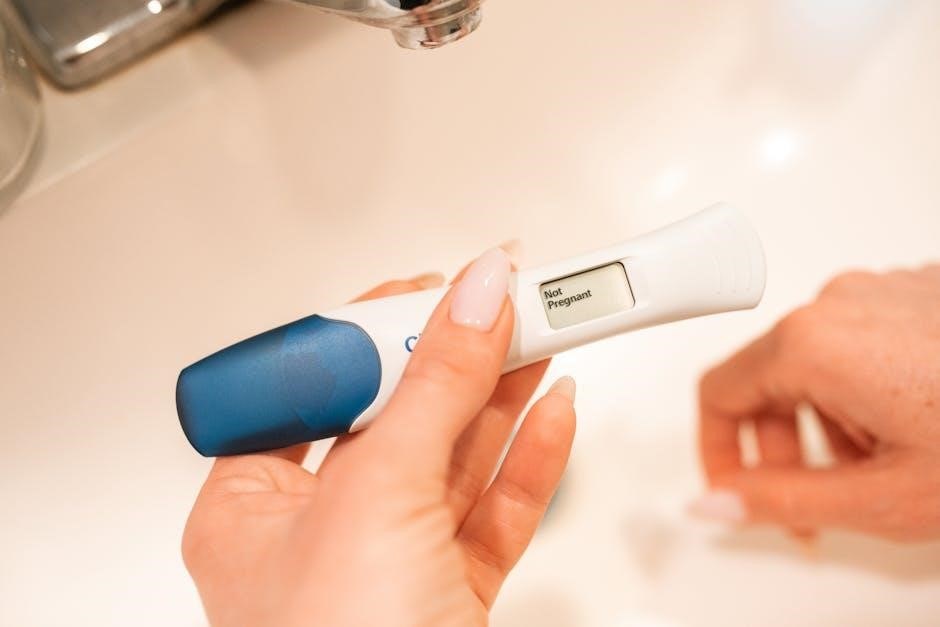
Embark on your journey with confidence using the most comprehensive and up-to-date information about pregnancy‚ labor‚ birth‚ and early postpartum care in Australia. This guide is tailored for expectant parents‚ offering practical advice and reassurance for a positive experience.
Early Stages of Pregnancy
The early stages of pregnancy‚ often spanning from conception to the end of the first trimester‚ are a period of profound change and development for both the mother and the developing fetus. This initial phase is characterized by a cascade of hormonal shifts that trigger a range of physical and emotional symptoms. Common early signs include a missed menstrual period‚ fatigue‚ nausea (often referred to as “morning sickness”)‚ breast tenderness‚ and frequent urination.
During this time‚ the fertilized egg rapidly divides and implants in the uterine lining‚ marking the beginning of embryonic development. Vital organs and body systems begin to form‚ making this a particularly sensitive period. Proper nutrition‚ including folic acid supplementation‚ is crucial to support healthy neural tube development.
Seeking early antenatal care is highly recommended. This involves confirming the pregnancy with a healthcare provider‚ discussing medical history‚ and receiving guidance on prenatal care. Early screening tests and ultrasounds may be conducted to assess the health and viability of the pregnancy. Understanding the timeline of development and potential risks is essential for informed decision-making.
Antenatal Care in Australia
Antenatal Care in Australia
Antenatal care in Australia is designed to provide comprehensive support and monitoring throughout pregnancy‚ ensuring the well-being of both the mother and the developing baby. This care typically involves regular check-ups with a healthcare provider‚ such as a general practitioner (GP)‚ obstetrician‚ or midwife. The frequency and nature of these appointments vary depending on individual needs and risk factors.
During antenatal visits‚ healthcare providers monitor the mother’s health through blood pressure checks‚ urine tests‚ and weight monitoring. They also track the baby’s growth and development through abdominal palpation‚ measuring fundal height‚ and listening to the fetal heartbeat. Ultrasound scans are routinely performed to assess the baby’s anatomy and confirm gestational age.
Antenatal care also includes providing education and guidance on various aspects of pregnancy‚ labor‚ and postpartum care. Topics covered include nutrition‚ exercise‚ managing common pregnancy discomforts‚ preparing for childbirth‚ and breastfeeding. Women are encouraged to ask questions and discuss any concerns they may have. Access to childbirth education classes and other support services is also an integral part of antenatal care in Australia‚ promoting informed decision-making and a positive pregnancy experience.
Preparing for Labor and Birth
Preparing for Labor and Birth
Preparing for labor and birth is a multifaceted process involving physical‚ emotional‚ and informational readiness. In Australia‚ numerous resources and approaches are available to help expectant parents navigate this transformative experience. Attending childbirth education classes is a crucial step‚ providing valuable knowledge about the stages of labor‚ pain management techniques‚ and potential interventions. These classes often cover breathing exercises‚ relaxation techniques‚ and positions for labor‚ empowering women to actively participate in their birth experience.
Creating a birth plan is another important aspect of preparation. This document outlines preferences for labor and delivery‚ including pain relief options‚ birthing positions‚ and who you want present during the birth. Discussing the birth plan with your healthcare provider ensures that your wishes are understood and respected.
Physical preparation involves maintaining a healthy lifestyle through regular exercise and a balanced diet. Strengthening exercises‚ such as squats and pelvic floor exercises‚ can improve stamina and prepare the body for labor. Gathering essential items for the hospital bag and preparing the home environment are also practical steps. Emotionally‚ building a strong support network and practicing mindfulness or relaxation techniques can help manage anxiety and promote a sense of calm as the due date approaches.
Pain Relief Options During Labor
Pain Relief Options During Labor

Labor pain is a unique and individual experience‚ and understanding the available pain relief options is essential for a positive birth experience. In Australia‚ a variety of methods are offered‚ ranging from non-pharmacological techniques to medical interventions. Non-pharmacological options include breathing exercises‚ massage‚ hydrotherapy (using water for pain relief)‚ and the use of a TENS (Transcutaneous Electrical Nerve Stimulation) machine. These methods can help manage pain and promote relaxation without the use of medication.
Pharmacological options include nitrous oxide (laughing gas)‚ which can provide mild pain relief and reduce anxiety. Epidural analgesia is a more potent form of pain relief‚ involving the injection of local anesthetic into the space around the spinal cord. Epidurals can provide significant pain relief but may also have side effects‚ such as a drop in blood pressure or difficulty with pushing.

Opioids‚ such as morphine‚ are another option‚ but they are less commonly used due to potential side effects for both the mother and baby. It’s important to discuss all pain relief options with your healthcare provider to determine the best approach for your individual needs and preferences. Having a clear understanding of the benefits and risks of each method will empower you to make informed decisions during labor.
Stages of Labor and Delivery
Stages of Labor and Delivery
Understanding the stages of labor and delivery can help you feel more prepared and empowered as you approach childbirth. Labor is typically divided into three main stages: the first stage‚ the second stage‚ and the third stage.
The first stage is the longest and is further divided into early labor‚ active labor‚ and transition. Early labor involves mild contractions that gradually become stronger and more frequent. Active labor is characterized by more intense and regular contractions‚ and the cervix dilates more rapidly. Transition is the final and most intense part of the first stage‚ as the cervix completes its dilation to 10 centimeters.
The second stage begins when the cervix is fully dilated and ends with the birth of the baby. This stage involves pushing with contractions to move the baby down the birth canal. The third stage begins after the baby is born and ends with the delivery of the placenta.
Each stage has its own set of challenges and milestones‚ and it’s important to work closely with your healthcare provider to navigate each one. Knowing what to expect can help you feel more in control and confident throughout the labor and delivery process. Remember that every labor is unique‚ and the duration of each stage can vary.
Postpartum Care for Mothers

Postpartum Care for Mothers
The postpartum period‚ often referred to as the fourth trimester‚ is a crucial time for maternal recovery and adjustment after childbirth. This period typically lasts for six to eight weeks and involves significant physical and emotional changes. Prioritizing self-care during this time is essential for your well-being.
Physical recovery involves healing from childbirth‚ whether it was a vaginal delivery or a cesarean section. Common issues include perineal pain‚ uterine cramping‚ and breast engorgement. Rest‚ proper nutrition‚ and gentle exercise can aid in the healing process. Seek guidance from healthcare professionals for pain management and wound care.
Emotional well-being is equally important. Many new mothers experience the “baby blues‚” characterized by mood swings and tearfulness. However‚ if these feelings persist or worsen‚ it’s crucial to seek help for postpartum depression or anxiety. Support from family‚ friends‚ and mental health professionals can be invaluable.
Establishing a routine‚ prioritizing sleep (when possible)‚ and maintaining a healthy diet can positively impact your physical and emotional recovery. Remember that you are not alone‚ and seeking help is a sign of strength. Connect with other new mothers in your community for shared experiences and support.
Newborn Care Essentials
Newborn Care Essentials
Caring for a newborn can feel overwhelming‚ but understanding the essentials will boost your confidence; Newborns require constant care‚ especially in the initial weeks. Feeding is paramount‚ whether you choose breastfeeding or formula. Breastfed babies typically feed on demand‚ while formula-fed babies need feeding every three to four hours.
Diaper changes are frequent‚ ensuring the baby’s comfort and hygiene. Use gentle wipes and apply diaper rash cream if needed. Swaddling can help soothe newborns‚ mimicking the security of the womb. Safe sleep practices are crucial; always place the baby on their back in a crib with a firm mattress and no loose bedding.
Bathing should be gentle and infrequent‚ about two to three times a week‚ to avoid drying out the skin. Use lukewarm water and mild‚ unscented soap. Cord care is essential until the umbilical cord stump falls off naturally. Keep the area clean and dry.
Monitoring your baby’s health includes tracking their temperature‚ weight‚ and overall well-being; Seek medical advice for any concerns‚ such as fever‚ feeding difficulties‚ or changes in behavior. Remember‚ every baby is unique‚ so trust your instincts and seek support when needed.
Common Pregnancy Complications

Common Pregnancy Complications
Pregnancy can sometimes involve complications that require careful monitoring and management. One common issue is gestational diabetes‚ a condition where blood sugar levels become elevated during pregnancy. Regular screening and dietary adjustments are crucial in managing this condition to ensure the health of both mother and baby.
Preeclampsia‚ characterized by high blood pressure and protein in the urine‚ is another serious complication. It can affect various organs and requires close medical supervision. In severe cases‚ early delivery may be necessary.
Placenta previa‚ where the placenta covers the cervix‚ can cause bleeding and may necessitate a cesarean delivery. Another placental issue‚ placental abruption‚ involves the premature separation of the placenta from the uterine wall and requires immediate medical attention.
Hyperemesis gravidarum‚ severe nausea and vomiting‚ can lead to dehydration and weight loss‚ often requiring hospitalization. Infections‚ such as urinary tract infections (UTIs)‚ are also common and should be promptly treated to prevent complications.
Maintaining regular prenatal check-ups and promptly reporting any unusual symptoms to your healthcare provider are essential for early detection and management of these and other potential pregnancy complications‚ ensuring the best possible outcome for you and your baby.
Psychological Well-being During and After Pregnancy
Psychological Well-being During and After Pregnancy

Pregnancy and the postpartum period are significant life transitions that can profoundly impact a woman’s psychological well-being. Hormonal changes‚ sleep deprivation‚ and the immense responsibility of caring for a newborn can contribute to emotional challenges. It’s crucial to acknowledge and address these feelings to ensure a healthy and positive experience.
Many women experience the “baby blues‚” characterized by feelings of sadness‚ anxiety‚ and irritability in the first few weeks after birth. While these feelings are often temporary‚ persistent or severe symptoms may indicate postpartum depression or anxiety‚ which require professional support.

Building a strong support network of family‚ friends‚ and healthcare providers is essential. Open communication with your partner and seeking help when needed can alleviate stress and promote emotional stability. Engaging in self-care activities‚ such as exercise‚ relaxation techniques‚ and hobbies‚ can also contribute to mental well-being.

It’s important to remember that seeking help for mental health concerns is a sign of strength‚ not weakness. Mental health professionals can provide valuable support and guidance during this transformative time‚ helping you navigate the challenges and embrace the joys of motherhood.

Australian Government Support for New Parents
Australian Government Support for New Parents
The Australian government provides a range of support services and financial assistance to help new parents navigate the challenges and joys of raising a family. These initiatives aim to ease the financial burden‚ promote parental well-being‚ and ensure access to essential resources.
One of the key forms of support is Parental Leave Pay‚ which provides eligible working parents with financial assistance during their time off work to care for their newborn or newly adopted child. This payment helps cover living expenses and allows parents to focus on bonding with their baby.
In addition‚ the government offers the Newborn Upfront Payment and Newborn Supplement‚ which provide a lump sum payment and ongoing financial assistance to eligible families. These payments can help with the initial costs of raising a child‚ such as purchasing essential baby items and covering healthcare expenses.

Beyond financial assistance‚ the Australian government also funds various programs and services to support new parents‚ including maternal and child health services‚ parenting education programs‚ and support groups. These resources provide valuable information‚ guidance‚ and a sense of community for new parents as they navigate the early years of parenthood.